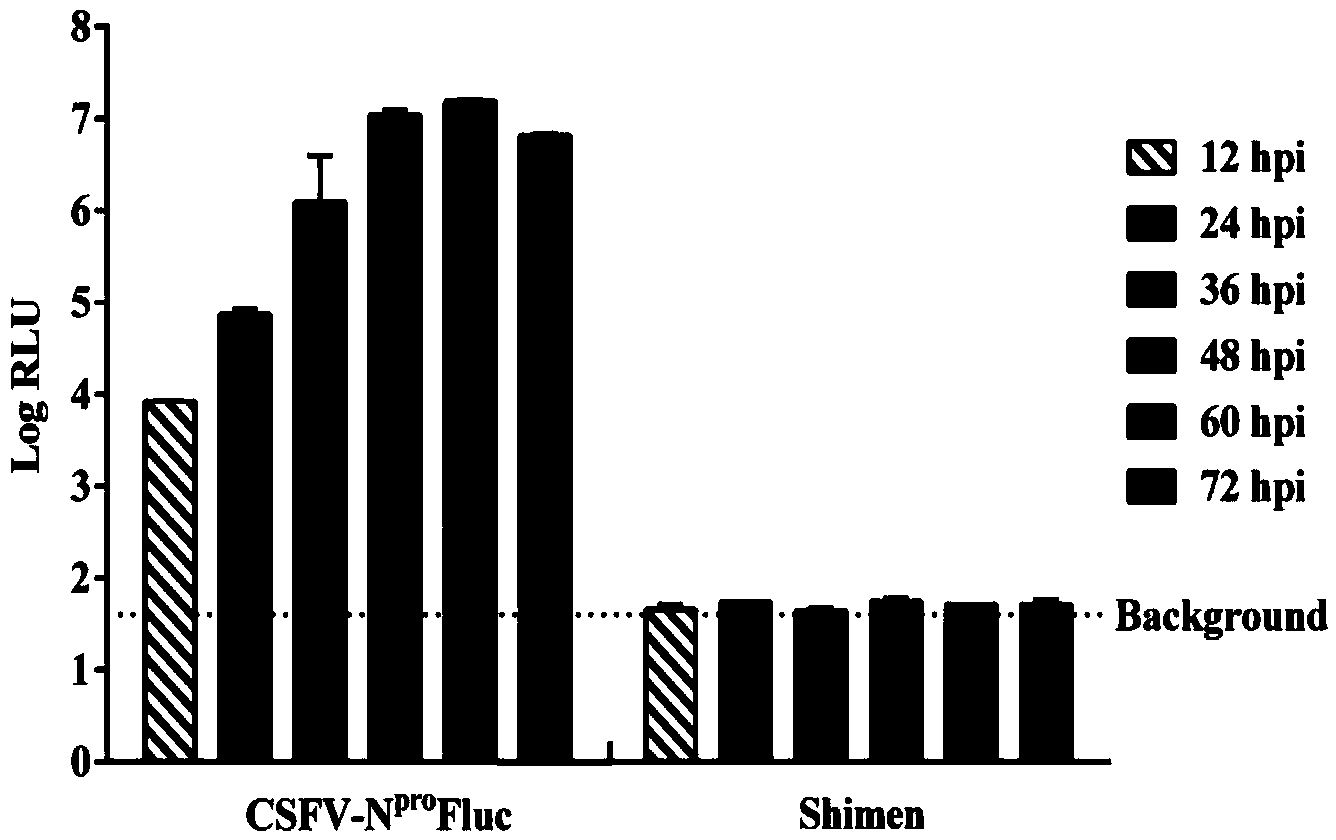Recombinant hog cholera virus for expressing firefly luciferase gene and application of recombinant hog cholera virus
A technology of luciferase gene and swine fever virus, which is applied in the direction of virus/phage, recombinant DNA technology, microbial measurement/inspection, etc., can solve the problems of high-throughput screening limitations and achieve the effect of saving time
- Summary
- Abstract
- Description
- Claims
- Application Information
AI Technical Summary
Problems solved by technology
Method used
Image
Examples
Embodiment 1
[0055] Example 1 Rescue of recombinant CSFV carrying Fluc gene
[0056] 1. Experimental method
[0057] 1.1 Construction of a full-length infectious clone carrying the Fluc gene
[0058] Primer N was designed according to the Fluc gene in the pGEM-luc plasmid pro Fluc-2-F / N pro Fluc-2-R (Table 1), using this plasmid as a template to amplify the Fluc gene; design primer N according to the full-length sequence of the parent virus Shimen strain pro Fluc-1-F / N pro Fluc-1-R and N pro Fluc-3-F / N pro Fluc-3-R (Table 1), use these two pairs of primers to amplify the gene fragment between the 215th-412th base and the 413th-684th base of the virus respectively; pro Fluc-1-F / N pro Fluc-3-R is a primer, and the fusion fragment Fluc-N is obtained by overlapping PCR pro , and this fusion fragment Fluc-N pro Linked to the pMD18-TSimple vector for sequencing identification.
[0059] Table 1 Primer names and their sequences
[0060]
[0061] Will sequence the correct Fluc-N pro ...
Embodiment 2
[0068] Example 2 Screening of recombinant swine fever virus
[0069] 1. Test method
[0070] 1.1 Luciferase activity analysis of recombinant virus
[0071] The luciferase activity of the five strains of recombinant CSFV rescued in Example 1 was detected with a dual-luciferase detection kit. SK6 cells were inoculated in a 24-well cell culture plate. When the cells grew to 80%, the SK6 cells were infected with the 5 strains of recombinant virus rescued in Example 1 and the Shimen strain of the parental virus by MOI=0.1 dose, and placed in 5% CO 2 , Continue culturing in a 37°C environment. At 12h, 24h, 36h, 48h, 60h, and 72h after infection, the cell culture supernatant was discarded, and the cells were washed once with PBS, and then 100 μL of lysate was added. After lysing on ice for 15 min, the cell lysate was added to the In the white plate of the enzyme detection reagent, immediately put it into the fluorescence detector for reading.
[0072] 1.2 Genetic stability analy...
PUM
 Login to View More
Login to View More Abstract
Description
Claims
Application Information
 Login to View More
Login to View More - Generate Ideas
- Intellectual Property
- Life Sciences
- Materials
- Tech Scout
- Unparalleled Data Quality
- Higher Quality Content
- 60% Fewer Hallucinations
Browse by: Latest US Patents, China's latest patents, Technical Efficacy Thesaurus, Application Domain, Technology Topic, Popular Technical Reports.
© 2025 PatSnap. All rights reserved.Legal|Privacy policy|Modern Slavery Act Transparency Statement|Sitemap|About US| Contact US: help@patsnap.com



